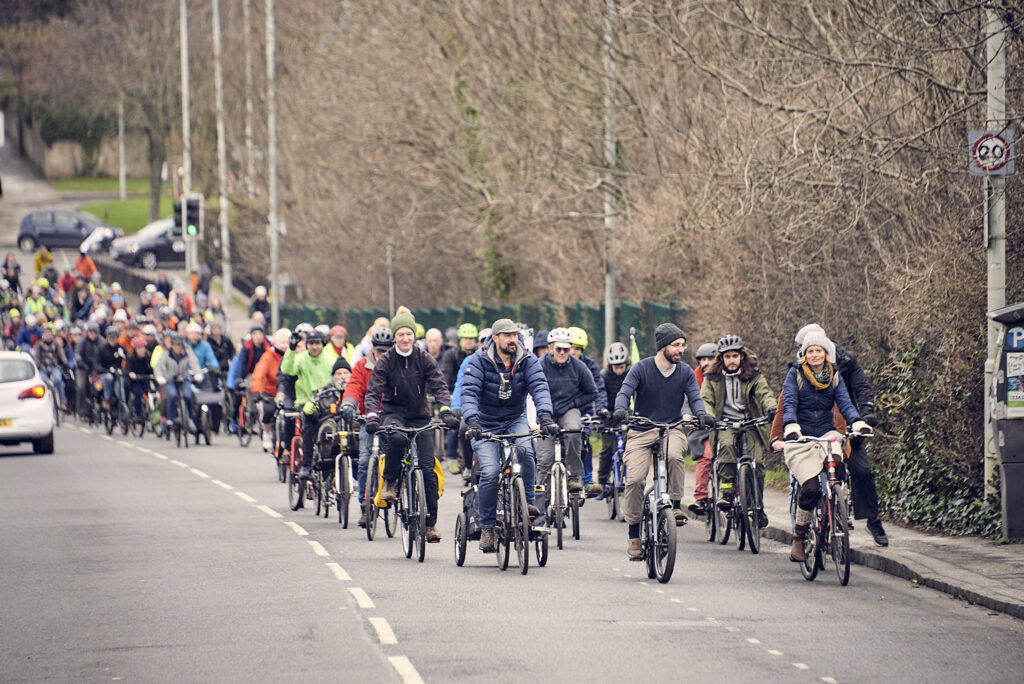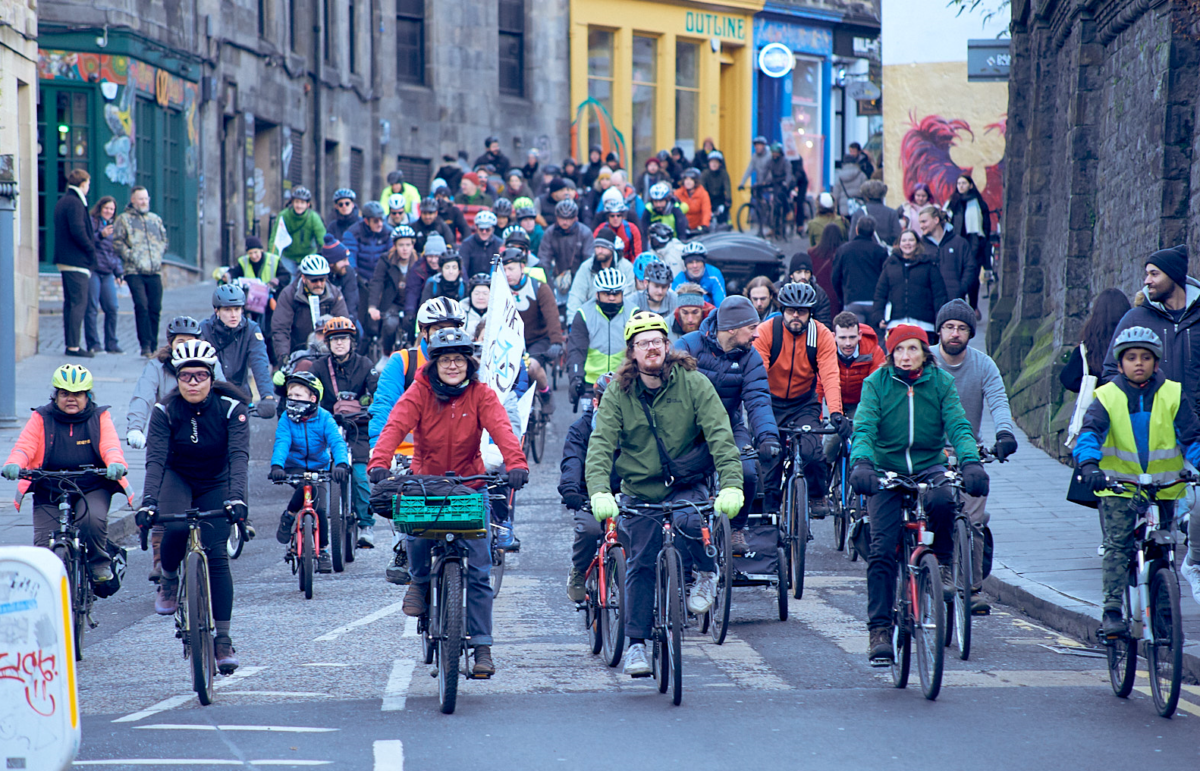A story about the positive impact of two community cycling groups in Edinburgh written by Douglas Rogers and funded through a SCCAN mini grant.
Cycling isn’t always easy – and that’s why we need communities
About a week after writing the words below, I heard the horrifying news that an 11-year-old boy was killed in a collision while cycling to school in Edinburgh.
This sort of infrastructurally determined violence is rare enough to remain shocking, but sadly also common enough to receive relatively little outcry – as was notably apparent in the Council’s readiness to roll back road-safety measures just hours after acknowledging Thomas Wong’s death.
We live in generally heartbreaking times, but I think it’s important to hold onto some heartbreak for and following such moments, and to remember that the safety of our streets is not some abstract political game. I also think it’s important to hold onto the vision of a kinder world, where people of all ages and backgrounds feel safe when they move.
My thoughts are with the family and memory of Thomas Wong, and will be every day I set foot on this city’s streets.
During my third really frightening close call, I started wondering if there was something different about cycling in Edinburgh.
Puffing away up Gloucester Lane’s steep cobbles, and newly coursing with adrenaline, I asked myself if I should think of this as a ‘near-death experience’. On its face this wasn’t far off: a two-tonne monster had just hurtled past me, with the space between us something under 30cm. Then again, such margins are hardly uncommon.
More disconcerting was the way it passed. A combustive roar competing with a blaring horn to drill an angry message deep into my head.
I pondered if the message’s author might not have known that I was following official guidance for turning right at junctions (‘you cannot get in the way of traffic: you are the traffic’), or if they knew but nonetheless felt importuned. My ears were still ringing.
There had been light rain earlier, and the cobbles were still sheeny slick enough to be a worry. Approaching the lane’s steepest section, I gave in to the temptation of changing down some gears. As I’d feared but hoped I could avoid, my penultimate gear-ring slipped precipitously, tearing through my breathless cadence and eviscerating my hard-earned momentum.
For the first time in my life, I wondered if perhaps I ought to find some other way to get around besides a bike.
An uphill battle
I grew up in Edinburgh. I was civic-minded enough to take a cycle safety course aged ten, but straight-laced enough to venerate car culture as much as anyone. I went down south for university, spent a stint in Amsterdam, then lived in London for a while.
During all of this I developed a deep love of cycling, one expression of which was a year spent zooming round London as a Deliveroo rider; another was the childish delight I found in replacing mid-length train journeys with multi-hour adventures.
A few years later I came back to Edinburgh. One of my many returning excitements was the thought of cycling here: unlike in London’s sprawl I would be capable of getting anywhere I needed within half an hour, lungs full of fresh Eden air, down roads and routes tended by a comparatively progressive political system.
I was slowly disillusioned. I thought I could beat any hill; this remained technically true, but sometimes the city’s other adversities could stack up to make the process pretty draining.
Sometimes it got cold enough that even hefty winter gloves didn’t save me from Raynaud’s, my fingers turning deathly pale and barely usable. Sometimes the wind blew hard enough to stop me in my tracks, suspended like a puppet. Some routes involved so many cobbles I’d get dizzy.
All of this poured cold water (often literal) on my confidence that Edinburgh would be an easy ride. But really, none of this was in itself a problem. Having lived in Amsterdam, where almost all the same headwinds exist, I know that physical factors play surprisingly modest roles in most places’ cyclability.
The thing that really killed me on those hills was culture.
If it’s strenuous slogging up Dundas street then it’s a lot worse doing so beneath the tetchy scrutiny of someone clinging to your rear. Especially if that person is at the controls of a vehicle more suitable for Operation Desert Storm than any plausible civilian application. Especially if the ideology driving that person is hardline car supremacy.
Sure, the danger/person/car might not be that bad – but it also might be, and you never really know until it’s in your face. Face enough close-passes, near-misses, man-eating potholes and Daedalian road-designs and you might, as I did, fall on an obstacle that’s far more draining than any winter weather: the feeling that you simply are not welcome on these streets when you’re on a bike.
Even as white male twentysomething, I was struck by just how much this feeling weighed on me, risking a vicious cycle of unhappy cycling begetting more unhappy cycling, those hills and temperatures and SUVs becoming ever more formidable.

Critical Mass
Two groups of people helped restore my sense of two-wheeled love and freedom.
The first was Critical Mass Edinburgh. Critical Mass (CM) is a loose and heterogeneous global movement, based around bringing cyclists together on unusually mobile ‘marches’, with the aim of normalising cycle-culture, helping new cyclists to build confidence, creating connections, and appealing ‘en masse’ for better cycle infrastructure (a technique which worked pretty well, to put it mildly, in The Netherlands).
In Edinburgh, Critical Mass takes place on the last Saturday of every month. It’s more family-friendly than some international equivalents: rides tend to be pleasant circuits of around two hours, featuring kids, eccentric bikes, occasional fancy-dress, and always boasting mobile sound-systems emitting upbeat beats. There’s reliably a chilled-out coda in a pub somewhere.
Involvement with CM did a lot to restore my faith in cycling. On a practical level, it’s been wonderful to draw on the community’s formidable pool of experience: most tangibly, tip-offs on life-alteringly useful gear like Bar Mitts and dynamos (my fragile hands are safe at last), and a culture of open-mindedness for alternate bike designs (including trikes, recumbents, cargo-bikes and e-bikes. I eventually went ahead and bought one of the latter, and it’s done a lot to take the edge off hills and gales).
Less tangible but equally important is the exchange of road wisdom: warnings about how to deal with tram-tracks, affirmations of ‘vehicular cycling’ as a strategy for survival pending road reform, reminders to steer clear of parked cars’ doors even in the face of frustrated pursuers, recommendations of routes for commuting or leisure.
But to me, none of this mattered so much as the sense of kinship and solidarity I’ve found with fellow riders. Validation, for example, that I’m not just being a snowflake for quailing at close-passes, and am not just being churlish about how Leith Walk has turned out. With roads now a frontline of the culture war, the exertion of riding is increasingly emotional as much as physical, and communities like CM Edinburgh can really help with this.
And another thing about communities is that they can connect with other ones.
Critical Mass Edinburgh meets on the last Saturday of every month at 2pm, Middle Meadow Walk.
Read Part 2 of Back in the saddle: Edinburgh’s Wee Spoke Hub

